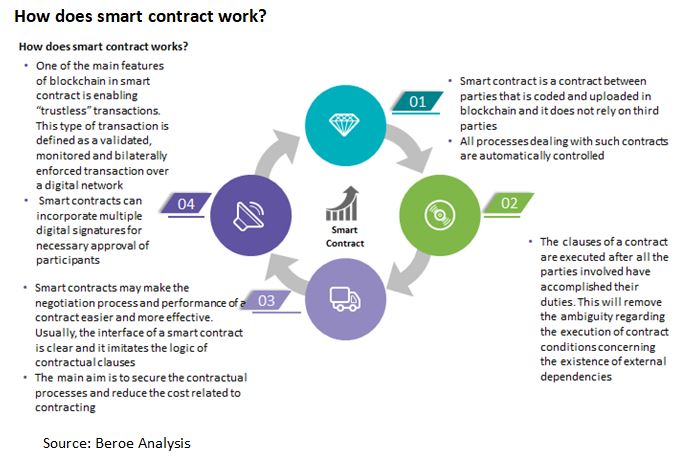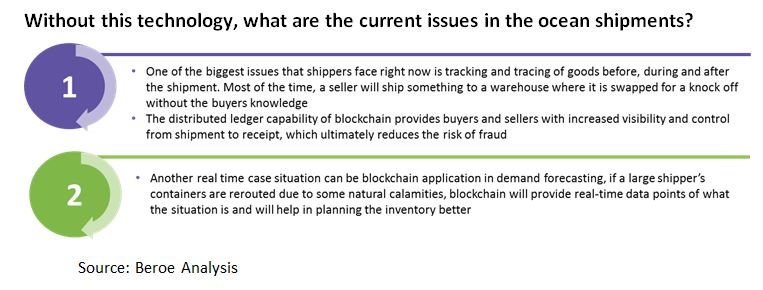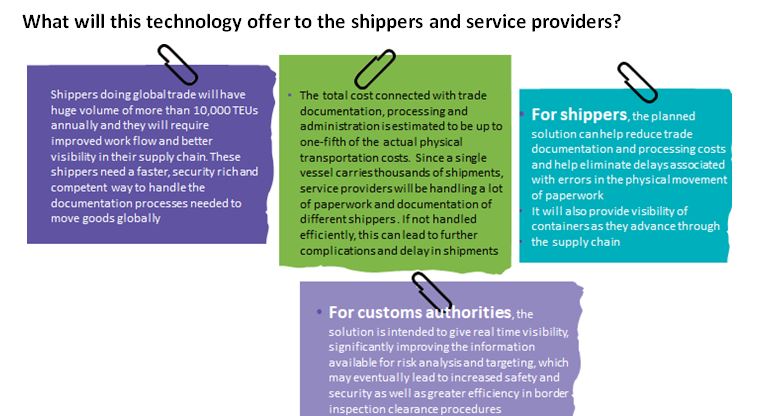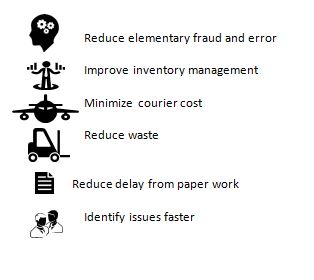
Improve ocean freight security with blockchain technology

Abstract
Top shipping liners are planning to collaborate with technology giants in the market to implement blockchain technology in shipping industry for digitizing, handling and tracking shipping transactions for end-to-end supply chain.
In this whitepaper, we will analyze the current challenges or issues in the ocean freight market and understand the opportunity for blockchain technology to provide massive savings, reducing lead time and cargo security when used broadly across the ocean freight ecosystem.
We also focus on how this technology is used in the shipping industry, detail value chain analysis of the parties involved, challenges during the execution and saving opportunities for shippers once the technology is implemented in the market.
Introduction
In the current scenario, about 85-90 percent of the cargo in global trade is transported by ocean freight every year which involves tens of millions of documents exchanged between different parties during the shipments. It is estimated that billions are wasted in the global trade due to usage of manual documentation process especially in ocean freight wherein paper work cost more than actual transportation cost.
With millions of transactions processed every day in shipping industry, the public blockchain will not only increase data efficiency, but also provide long term savings for electronic data interchange (EDI) companies.
Maersk in collaboration with IBM has built a blockchain solution for digitalizing all the transactions during the cargo movement, to improve transparency among all the parties involved and to increase security of information during the transaction.
Maersk will identify the best ocean lanes for implementing the solution in the initial stage by linking all the major shippers, freight forwarders, other ocean carriers, ports and customs authorities.
What is blockchain technology and how is it applied in ocean freight?
Blockchain technology is described as a secure way to share information between parties, creating a permanent, digital public ledger of transactions which can be shared among a distributed network of computers without need for a central authority such as a bank. It maintains a continuously growing list of records or transactions, called blocks, which are secure from tampering, hacking or revision.
Certain key aspects of using blockchain technology in shipping industry include:
Security: No one involved in the supply chain can modify, delete or even append any record without the accord from other parties on the network. This level of transparency helps reduce fraud and errors, reduce the time spent in the transit and shipping process, improve inventory and reduce waste and cost.
Transparency in the supply chain: All the parties involved in the supply chain ecosystem can view the progress of goods transported through the supply chain. They can also see the status of customs documents, view bills of lading and other key data.
Real time visibility: Detailed visibility of the container’s progress through the supply chain is enhanced with the real time exchange of original supply chain events and documents.
It is observed that one of the key applications of block chain in shipping industry is automation of key processes using smart contracts. These contracts can be executed automatically based on the fulfillment of certain conditions. Given the amount of complex paperwork in the supply chain, there is potential for creating smart contracts in many areas for speed, trust and security.
Smart contracts could eliminate major steps in shipping such as issuing bills of lading and customs papers and also reduce a number of third parties involved in multiple transactions.
What are the initiatives taken to implement blockchain technology?
Top shipping liner Maersk has explored the possibility of using blockchain technology in certain routes in which about two hundred possible transactions in a cargo shipment are digitalized with the help of blockchain that used a shared and decentralized database.
Maersk has executed a shipment of flowers from East Africa to Northern Europe in 2014 using blockchain technology. For this single shipment, shipper and consignee had interacted with more than 28 different entities such as customs, terminals, shipping lines, forwarders, etc. and involved multiple manual documentation which can be eliminated by blockchain technology.
Maersk has done a pilot shipment for transporting flowers from East Africa to Northern Europe.
Case 1: Shipment of cargo without the usage of blockchain technology during the movement
Shipments should pass through multiple parties increasing potential delay in transportation
Case 2: Shipment of cargo using blockchain technology during the movement
- All the parties involved have end-to-end visibility of container progress through the supply chain
- The container arrives at the destination port and clears customs
- Retailer receives the products on time and signs electronically. Information is relayed back to blockchain
- Blockchain helps enable unprecedented, secure transparency across the supply chain
Blockchain helps different parties involved in the supply chain
Companies adopting blockchain technology for different activities in cargo transportation via ocean
Blockchain technology is already being used in logistics industry, for instance by US-based Marine Transport International (MIT). The company uses it to record and store verified gross mass (VGM) data. Instead of a VGM message being delivered sequentially to parties within the supply chain, MIT’s platform can provide a decentralised approach to delivering VGM messages.
Cost savings opportunities for large BCOs
Let us assume that a large shipper from pharmaceutical or consumer goods industry ships about 10,000 TEUs of cargo on a global level engaging with multiple liners and freight forwarders in the market. As per the caculation, it is estimated that normal shipments with manual documentation takes about one fifth of the total freight cost. By utilizing blockchain technology for all the shipments on an annual basis, the approximate calculation of cost savings that can be achieved after reducing all the extra charges will be as given below:
|
Cost Calculation Assumption |
Cost in USD |
|
Shipment cost/20’ container |
Approx. 1,000 |
|
Annual shipping cost(10,000 TEUs) |
Approx.10 million |
|
Mimimum Cost saving achieved |
About 1 million |
Note: These are indicative numbers which will be different in real time scenario, done only for analysing the advantage of this technolgy if implemented on a large sacle over a period of time
Conclusion
While adoption of blockchain technology in logistics industry is in the preliminary stages, a few large shipping liners and freight forwarders have started exploring the advantage and cost savings that can be achieved when implemented on a large scale. One of the major reasons for limited adoption is the risks associated with the technology such as privacy and data governance. Despite skepticism, the technology is likely to win the support and confidence of companies in the industry given its broader benefits.
Related Insights:
View All
Get more stories like this
Subscirbe for more news,updates and insights from Beroe













